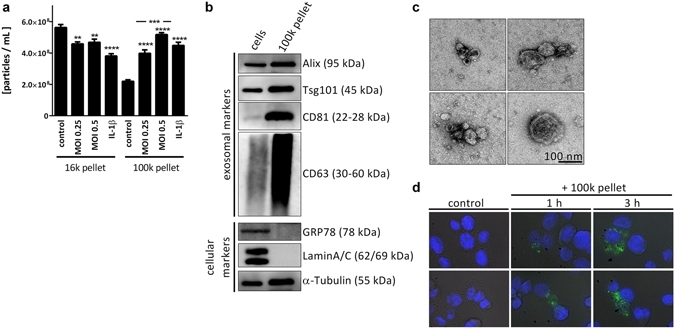DAPI
4,6-Diamidino-2-phenylindole, dihydrochloride; 10 mM solution in water
DAPI is a fluorescent stain that binds strongly to DNA. It is used extensively in fluorescence microscopy. Since DAPI passes through an intact cell membrane, it can be used to stain live cells besides fixed cells. For fluorescence microscopy, DAPI is excited with ultraviolet light. When bound to double-stranded DNA its absorption maximum is at 358 nm and its emission maximum is at 461 nm. One drawback of DAPI is that its emission is fairly broad. DAPI also binds to RNA although it is not as strongly fluorescent as it binds to DNA. Its emission shifts to around 500 nm when bound to RNA. DAPI's blue emission is convenient for multiplexing assays since there is very little fluorescence overlap between DAPI and green-fluorescent molecules like fluorescein and green fluorescent protein (GFP), or red-fluorescent stains like Texas Red. Besides labeling cell nuclei, DAPI is also used for the detection of mycoplasma or virus DNA in cell cultures.
Calculators
Common stock solution preparation
Table 1. Volume of Water needed to reconstitute specific mass of DAPI [4,6-Diamidino-2-phenylindole, dihydrochloride] *10 mM solution in water* to given concentration. Note that volume is only for preparing stock solution. Refer to sample experimental protocol for appropriate experimental/physiological buffers.
| 0.1 mg | 0.5 mg | 1 mg | 5 mg | 10 mg | |
| 1 mM | 285.51 µL | 1.428 mL | 2.855 mL | 14.276 mL | 28.551 mL |
| 5 mM | 57.102 µL | 285.51 µL | 571.021 µL | 2.855 mL | 5.71 mL |
| 10 mM | 28.551 µL | 142.755 µL | 285.51 µL | 1.428 mL | 2.855 mL |
Molarity calculator
Enter any two values (mass, volume, concentration) to calculate the third.
| Mass (Calculate) | Molecular weight | Volume (Calculate) | Concentration (Calculate) | Moles | ||||
| / | = | x | = |
Spectrum
Alternative formats
Citations
View all 54 citations: Citation Explorer
Inhibitory impact of a mesoporous silica nanoparticle-based drug delivery system on Porphyromonas gingivalis-induced bone resorption
Authors: Li, Mengya and Sun, Jian and Zhao, Dong and Zhang, Wen and Xu, Qingan
Journal: Journal of Materials Science: Materials in Medicine (2024): 56
Authors: Li, Mengya and Sun, Jian and Zhao, Dong and Zhang, Wen and Xu, Qingan
Journal: Journal of Materials Science: Materials in Medicine (2024): 56
Temperature switchable linkers suitable for triggered drug release in cancer thermo-chemotherapy
Authors: Ye, Junxiao and Cui, Hui and Liu, Ergang and Pei, Xing and Chai, Meihong and Sun, Lu and Wang, Dongmei and Yang, Victor C and Yu, Fei
Journal: International Journal of Pharmaceutics (2024): 124757
Authors: Ye, Junxiao and Cui, Hui and Liu, Ergang and Pei, Xing and Chai, Meihong and Sun, Lu and Wang, Dongmei and Yang, Victor C and Yu, Fei
Journal: International Journal of Pharmaceutics (2024): 124757
Tristetraprolin affects invasion-associated genes expression and cell motility in triple-negative breast cancer model
Authors: Hubiernatorova, Anastasiia and Novak, Josef and Vaskovicova, Michaela and Sekac, David and Kropyvko, Serhii and Hodny, Zdenek
Journal: Cytoskeleton (2024)
Authors: Hubiernatorova, Anastasiia and Novak, Josef and Vaskovicova, Michaela and Sekac, David and Kropyvko, Serhii and Hodny, Zdenek
Journal: Cytoskeleton (2024)
An NIR-responsive hydrogel loaded with polydeoxyribonucleotide nano-vectors for enhanced chronic wound healing
Authors: Sun, Yanzhen and Li, Yao and Ding, Xiaokang and Xu, Pan and Jing, Xiaodong and Cong, Hailin and Hu, Hao and Yu, Bing and Xu, Fu-Jian
Journal: Biomaterials (2024): 122789
Authors: Sun, Yanzhen and Li, Yao and Ding, Xiaokang and Xu, Pan and Jing, Xiaodong and Cong, Hailin and Hu, Hao and Yu, Bing and Xu, Fu-Jian
Journal: Biomaterials (2024): 122789
Deciphering the Role of Ferroptosis in Rheumatoid Arthritis: Synovial Transcriptome Analysis and Immune Infiltration Correlation
Authors: Wang, Hongli and Zhang, Miaomiao and Hu, Yiping and He, Juan and Zhong, Yuchao and Dai, Yong and Wang, Qingwen
Journal: Heliyon (2024)
Authors: Wang, Hongli and Zhang, Miaomiao and Hu, Yiping and He, Juan and Zhong, Yuchao and Dai, Yong and Wang, Qingwen
Journal: Heliyon (2024)
References
View all 134 references: Citation Explorer
DNA staining with the fluorochromes EtBr, DAPI and YOYO-1 in the comet assay with tobacco plants after treatment with ethyl methanesulphonate, hyperthermia and DNase-I
Authors: Gichner T, Mukherjee A, Veleminsky J.
Journal: Mutat Res (2006): 17
Authors: Gichner T, Mukherjee A, Veleminsky J.
Journal: Mutat Res (2006): 17
Physical localization of ribosomal genes and chromosome DAPI banding by in situ hybridization in Medicago sativa L
Authors: Chen JM, Hong YH, Wang YP, Bowley S, Wan JM.
Journal: Yi Chuan (2006): 184
Authors: Chen JM, Hong YH, Wang YP, Bowley S, Wan JM.
Journal: Yi Chuan (2006): 184
Identification of all pachytene bivalents in the common shrew using DAPI-staining of synaptonemal complex spreads
Authors: Belonogova NM, Karamysheva TV, Biltueva LS, Perepelov EA, Minina JM, Polyakov AV, Zhdanova NS, Rubtsov NB, Searle JB, Borodin PM.
Journal: Chromosome Res (2006): 673
Authors: Belonogova NM, Karamysheva TV, Biltueva LS, Perepelov EA, Minina JM, Polyakov AV, Zhdanova NS, Rubtsov NB, Searle JB, Borodin PM.
Journal: Chromosome Res (2006): 673
Reliable DNA ploidy determination in dehydrated tissues of vascular plants by DAPI flow cytometry--new prospects for plant research
Authors: Suda J, Travnicek P.
Journal: Cytometry A (2006): 273
Authors: Suda J, Travnicek P.
Journal: Cytometry A (2006): 273
Investigation of chromosomes in varieties and translocation lines of pea Pisum sativum L. by FISH, Ag-NOR, and differential DAPI staining
Authors: Samatadze TE, Muravenko OM, Bol'sheva NL, Amosova AB, Gostimsckii SA, Zelenin AV.
Journal: Genetika (2005): 1665
Authors: Samatadze TE, Muravenko OM, Bol'sheva NL, Amosova AB, Gostimsckii SA, Zelenin AV.
Journal: Genetika (2005): 1665
Page updated on September 19, 2024




